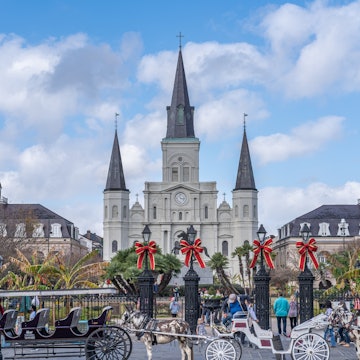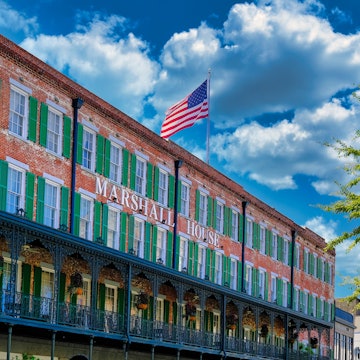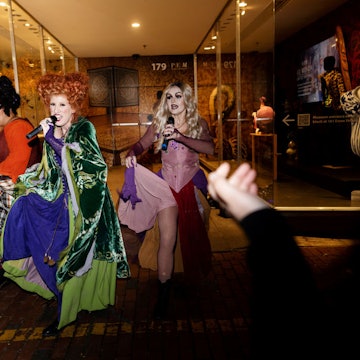

Everything you need to know about second lines and how to join one © Suzanne C. Grim / Shutterstock
The band struck up “Knock With Me, Rock With Me,” by the Lil’ Rascals Brass Band. Or maybe it was “Feel Like Funkin’ It Up” by Rebirth. Or just a cover of “Can’t Take My Eyes Off Of You.” I dunno – any of those songs could be played on any corner, in any second line parade, here in New Orleans, any time of year.
Second lines are open to everyone and are often family-friendly. You’ll see kids waving handkerchiefs alongside older generations who’ve been “second-lining” for decades. While the energy can get boisterous, the focus is on community and joy. Just wear comfortable shoes, bring water (or something stronger if that’s your vibe), and join the fun.
What is a second line?
So, what is a second line? In simple terms, it’s an informal neighborhood parade where a brass band leads (the “first line”) and a crowd of revelers follows, dancing and celebrating, hence becoming the “second line.” They really can kick off at any time – people will hire a brass band to play for, say, a spouse’s birthday, and when neighbors fall in behind the band as it moves through the streets, that’s a second line (the band itself is the first line).
The history of the second line
This tradition goes way back in the history of New Orleans African Americans. Black mutual aid societies were formed after the Civil War, providing services like healthcare and funerals. Brass bands played a key role in these celebrations and jazz funerals. By the late 19th century, the societies began holding annual parades with music, evolving into today’s second line tradition. These parades are now largely organized by Social Aid & Pleasure Clubs (SAPCs), which continue to host second lines as a way to celebrate community and culture.
Where can you find a second line?
Second lines are an organic sort of celebration – while larger parades warrant street permits and planning, others kick off with little to no warning.
Find the right neighborhood
If you’re staying in the French Quarter or Central Business District, you may well spot a brass band leading what we’d call ‘corporate second lines’ – bands are hired to play for the many conferences that are held in New Orleans, followed by an inevitably confused pack of business people roped into an often wooden procession. On the other hand, in the same neighborhoods, you may spot a band, a bride, a groom, and a second line parade with the wedding party dancing joyfully in the streets – a celebration that's a much more representative version of the ‘real’ thing.
Check social clubs and websites
The second lines put on by Social Aid & Pleasure Clubs are the easiest to find, by dint of their being listed on the Takin’ It To The Streets section of the webpage for WWOZ, the city’s most iconic radio station. You’ll find exact details of where the parade starts and the entire marching route – which can last well over a mile.

How to join a second line
Show up on time – second lines aren’t always punctual, but you don’t want to miss the start, and a street party always congregates before the main event in any case. Folks grill meat and sell drinks while clustered around a house or bar where the sponsoring Social Aid & Pleasure Club members don suits, often accented with intricate bead or feather work, a nod to the Mardi Gras Indians, another component of the city’s African American ‘backstreet’ culture.
When the time is right, the band kicks off and the members of the SAPC emerge onto the street, dancing and shuffling to the front of the procession as a crowd falls in behind them. The second line then follows a predetermined route, attracting followers along the way – an initial parade of a few hundred can easily swell to a thousand, or many more (fair warning: second lines are not fun if large crowds aren’t your thing). You’re absolutely welcome to march with the crowd – it’s expected! Staying near the band is a good way of pumping the city’s music directly into your veins.
The parade makes stops at well-known bars, where participants dance, load up on drinks, or just slip away – you don’t have to follow a second line for its entire length to feel like you’ve experienced it. SAPC second lines take place in the city’s Black residential areas and are loosely divided into Uptown and Downtown parades, with Canal St serving as the line of delineation.
Parade routes and transport options
Check WWOZ to figure out where the parade starts and consider getting a taxi there. A cab or ride service will probably have to drop you off at the edge of the second line pregame party, but better to walk a few blocks than look for street parking, which can be scarce depending on the neighborhood. Plus, if you end up leaving the parade early, you don’t have to hoof it back to your vehicle.
That said, SAPC second lines often make a loop, so if you stick with the parade you might end up back where you started – again, check the route map on the WWOZ website to confirm this. Biking to a second line eliminates the need for parking, but you’ll still have to walk back to your bicycle, as pushing a bike along with the crowd feels intrusive.

Keep the party going
The average second line can last for well over a mile, or far more. By the time you reach the end, you will have gotten some steps in, and possibly, some whiskey or beer from the hustling entrepreneurs who always follow the parade with a cooler. The point is, plenty of people feel too wiped to carry on when the parade dissipates.
If you leave the parade early, or just have superhuman stamina, keep in mind that second lines usually move through residential areas. If you need to peel off to sit at a bar or grab something to eat, there are often many businesses in the vicinity where you can scratch that itch, because, y’know, New Orleans.

How to prepare for a second line
Remember the following tips before you join a second line:
Build that cardio – dancing and moving through the streets of the city can easily wear you out.
Bring water, as the city is still plenty hot in most of spring and fall.
Wear some comfortable shoes, and keep some cash to spend on local food and libations.
Don’t hinder the band or parade leaders when taking photos.
Keep up on the location of a parade via WWOZ – this is your ticket to actually finding the party.
Be warned, if you bring kids the music can be loud and the walking can be hard on little ones. Otherwise, have an open mind, respect parade etiquette (i.e. don’t block the band), and enjoy the show – while the rest of the USA spends Sunday running errands, down here, we’re trying to push the beat across the whole (or at least, a sizable chunk of) the city.
















